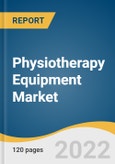The global physiotherapy equipment market size is expected to reach USD 33.5 billion by 2030, registering a CAGR of 6.69% from 2022 to 2030. The growing prevalence of neurological, musculoskeletal, and spinal cord disorders, early disease diagnosis, and awareness about physiotherapy are some of the factors driving the market growth. The rising incidences of sports injuries, cerebrovascular diseases, and degenerative joint disorders are also contributing to the market growth. According to the National Safety Council (NSC), biking was responsible for 426,000 injuries in 2020, the most of any sport or recreational activity. With roughly 378,000 injuries, (with or without equipment) exercise ranked second, followed by ATV, minibike, and moped use (with 230,000 injuries) and scooter, hoverboard, and skateboard use (with 218,000 injuries) in the U.S.
Increasing technological advancements such as the use of robotic support systems, implantable gadgets, and exoskeletons are aiding market expansion. Manufacturers are also spending in research and development (R&D) activities in order to release improved and user-friendly equipment that will improve patient care and comfort. Furthermore, increasing healthcare spending is expected to fuel the industry even further. One of the growing trends in the market is the use of video games and rehabilitation robots. NINTENDO WII, a video game, has proven to be beneficial in the rehabilitation process. While playing the game, patients need to perform repetitive movements such as rolling a bowling alley ball or swinging a tennis racket, which in turn helps patients in the movement of muscles and maintains coordination between balance and movement.
The rising need for new therapies along with the commercialization of various equipment is expected to boost market growth in the coming years. In January 2019, Quantum Cryogenics launched CryoQube, a whole-body cryotherapy chamber, due to growing demand for the therapy in U.K. During the COVID-19 pandemic, government-imposed restrictions, and bans on medical treatments including elective surgeries. The need for physiotherapy equipment has been limited by these restrictions. Physiotherapy equipment manufacturers encountered issues in conducting in-person product presentations, continuing work at full capacity, and attending events that help generate future sales prospects as a result of these constraints. This coupled with the temporary closure of various physiotherapy offices declined the overall sales of the products. Furthermore, the shutdown in Asia Pacific countries such as China and India has caused a delay in product manufacturing and distribution. The aforementioned factors negatively impacted the phy
siotherapy equipment market growth.
This product will be delivered within 1-3 business days.
Increasing technological advancements such as the use of robotic support systems, implantable gadgets, and exoskeletons are aiding market expansion. Manufacturers are also spending in research and development (R&D) activities in order to release improved and user-friendly equipment that will improve patient care and comfort. Furthermore, increasing healthcare spending is expected to fuel the industry even further. One of the growing trends in the market is the use of video games and rehabilitation robots. NINTENDO WII, a video game, has proven to be beneficial in the rehabilitation process. While playing the game, patients need to perform repetitive movements such as rolling a bowling alley ball or swinging a tennis racket, which in turn helps patients in the movement of muscles and maintains coordination between balance and movement.
The rising need for new therapies along with the commercialization of various equipment is expected to boost market growth in the coming years. In January 2019, Quantum Cryogenics launched CryoQube, a whole-body cryotherapy chamber, due to growing demand for the therapy in U.K. During the COVID-19 pandemic, government-imposed restrictions, and bans on medical treatments including elective surgeries. The need for physiotherapy equipment has been limited by these restrictions. Physiotherapy equipment manufacturers encountered issues in conducting in-person product presentations, continuing work at full capacity, and attending events that help generate future sales prospects as a result of these constraints. This coupled with the temporary closure of various physiotherapy offices declined the overall sales of the products. Furthermore, the shutdown in Asia Pacific countries such as China and India has caused a delay in product manufacturing and distribution. The aforementioned factors negatively impacted the phy
siotherapy equipment market growth.
Physiotherapy Equipment Market Report Highlights
- Based on application, the musculoskeletal segment dominated the market in 2021 due to the rising prevalence of musculoskeletal disorders and the ability of physiotherapy to prevent and reduce their adverse effects.
- North America held the largest market share in 2021 due to the increase in baby boomer population, the presence of favorable government policies, and sophisticated healthcare infrastructure.
- The market in Asia Pacific is expected to witness lucrative growth over the forecast period owing to the rise in population, high investment opportunities, and developing healthcare infrastructure.
This product will be delivered within 1-3 business days.
Table of Contents
Chapter 1 Methodology and Scope
Chapter 2 Executive Summary
Chapter 3 Market Variables, Trends & Scope
Chapter 4 Physiotherapy Equipment Market: Application Analysis
Chapter 5 Physiotherapy Equipment Market: Type Analysis
Chapter 6 Physiotherapy Equipment Market: Demographics Analysis
Chapter 7 Physiotherapy Equipment Market: End Use Analysis
Chapter 8 Physiotherapy Equipment Market: Regional Analysis
Chapter 9 Competitive Analysis
Companies Mentioned
- Enraf-Nonius B.V.
- Btl
- Ems Physio Ltd.
- Dynatronics Corporation
- Richmar
- Performance Health
- Storz Medical AG
- Zimmer Medizinsysteme GmbH
- Whitehall Manufacturing
- Ito Co. Ltd.
Methodology

LOADING...
Table Information
| Report Attribute | Details |
|---|---|
| No. of Pages | 120 |
| Published | April 2022 |
| Forecast Period | 2022 - 2030 |
| Estimated Market Value ( USD | $ 19.9 Billion |
| Forecasted Market Value ( USD | $ 33.5 Billion |
| Compound Annual Growth Rate | 6.6% |
| Regions Covered | Global |
| No. of Companies Mentioned | 10 |









